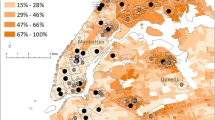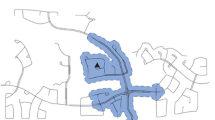Abstract
OBJECTIVES: To identify characteristics of the food environment associated with child overweight/obesity that could, if subjected to intervention, mitigate the risk of childhood overweight/obesity. We examined whether the proximity to or density of grocery and convenience stores or fast food restaurants, or the prices of healthy food options were more strongly associated with overweight/obesity risk in children.
METHODS: We collected geocoded data by residential addresses for 1,469 children aged 10-14 years and conducted a census of all food outlets in Saskatoon. The Nutrition Environment Measures Survey (NEMS-Stores and the NEMS-Restaurants were used to measure availability, quality and relative price of healthy food items in stores and restaurants. Children’s weight status was calculated on the basis of measured height and weight. Logistic regression was used to test the associations between overweight/obesity and food environment variables.
RESULTS: Within an 800 m walking distance from home, 76% of children did not have access to a grocery store; 58% and 32% had access to at least one convenience store or one fast-food restaurant respectively. A significantly lower odds of overweight/obesity was associated with lower price of healthy food items/options in grocery stores (odds ratio [OR] = 0.87, 95% confidence interval [CI] 0.77-0.99) and fast-food restaurants (OR = 0.97, 95% CI 0.95-0.99) within walking distance of home. Neither the distance to the closest food outlet nor the density of food outlets around children’s homes was associated with odds of overweight/obesity.
CONCLUSIONS: Improving economic access to healthy food in food outlets or fast-food restaurants is one strategy to counter childhood overweight/obesity.
Résumé
OBJECTIFS : Cerner les caractéristiques de l’environnement alimentaire associées au surpoids/à l’obésité des enfants qui pourraient, si elles étaient soumises à une intervention, atténuer le risque de surpoids/d’obésité juvénile. Nous avons cherché à déterminer si la proximité ou la densité des épiceries, des dépanneurs ou des restaurants rapides, ou les prix des choix alimentaires sains, étaient plus fortement associés au risque de surpoids/d’obésité chez les enfants.
MÉTHODE : Nous avons recueilli des données géocodées par adresse résidentielle pour 1,469 enfants de 10-14 ans et recensé tous les points de vente alimentaires de Saskatoon. Nous avons utilisé les sondages Nutrition Environment Measures Survey (NEMS-Stores et NEMS-Restaurants pour mesurer la disponibilité, la qualité et le prix relatif des produits alimentaires dans les magasins et les restaurants, respectivement. Le statut pondéral des enfants a été calculé à partir de la taille et du poids mesurés. Nous avons procédé par régression logistique pour tester les associations entre le surpoids/l’obésité et les variables de l’environnement alimentaire.
RÉSULTATS : À distance de marche de 800 m de leur domicile, 75% des enfants n’avaient pas accès à une épicerie; 60% et 33% avaient accès à au moins un dépanneur ou un restaurant rapide, respectivement. Une probabilité significativement plus faible de surpoids/d’obésité était associée aux prix plus bas des produits ou des choix alimentaires sains dans les épiceries (rapport de cotes [RC] = 0.87, intervalle de confiance [IC] de 95%: 0.77-0.99) et les restaurants rapides (RC = 0.97, IC de 95%: 0.95-0.99) situés à distance de marche du domicile. Ni la distance du point de vente alimentaire le plus proche, ni la densité des points de vente alimentaires autour des domiciles des enfants n’était associée à la probabilité de surpoids/d’obésité.
CONCLUSIONS : Améliorer l’accès économique aux aliments sains dans les points de vente alimentaires ou les restaurants rapides est une stratégie pour contrer le surpoids/l’obésité juvénile.
Similar content being viewed by others
References
Roberts KC, Shields M, De Groh M, Aziz A, Gilbert JA. Overweight and obesity in children and adolescents: Results from the 2009 to 2011 Canadian Health Measures Survey. Health Rep 2012;23(3):37–41. PMID: 23061263. Catalogue no. 82-003-XPE.
Summerbell CD, Waters E, Edmunds LD, Kelly S, Brown T, Campbell KJ. Interventions for preventing obesity in children. Cochrane Database Syst Rev 2005;3:1–70. PMID: 16034868. doi: 10.1002/14651858.CD001871.pub2.
Morland K, Wing S, Roux AD. The contextual effect of the local food environment on residents’ diets: The atherosclerosis risk in communities study. Am J Public Health 2002;92(11):1761–68. PMID: 12406805. doi: 10.2105/AJPH.92.11.1761.
Laraia BA, Siega-Riz AM, Kaufman JS, Jones SJ. Proximity of supermarkets is positively associated with diet quality index for pregnancy. Prev Med 2004; 39(5):869–75. PMID: 15475018. doi: 10.1016/j.ypmed.2004.03.018.
Wang MC, Gonzalez AA, Ritchie LD, Winkleby MA. The neighborhood food environment: Sources of historical data on retail food stores. Int J Behav Nutr Phys Act 2006;3(1):15. PMID: 16846518. doi: 10.1186/1479-5868-3-15.
Glanz K, Sallis JF, Saelens BE, Frank LD. Healthy nutrition environments: Concepts and measures. Am J Health Promot 2005;19(5):330–33. PMID: 15895534. doi: 10.4278/0890-1171-19.5.330.
Holsten JE. Obesity and the community food environment: A systematic review. Public Health Nut 2009;12(3):397–405. PMID: 18477414. doi: 10.1017/S1368980008002267.
Engler-Stringer R, Muhajarine N, Le H, Del Canto S, Ridalls T. Characterizing the Food Environment in Saskatoon for Families with Children: Research Methods and Descriptive Results. Saskatchewan Population Health and Evaluation Research Unit, Saskatoon 2014. Available at: http://www.spheru.ca/publications/files/FINAL%20Food%20Environment%20Technical% 20Report.pdf (Accessed April 17, 2016).
WHO AnthroPlus for personal computers Manual: Software for assessing growth of the world’s children and adolescents. Geneva: World Health Organization, 2009. Available at: http://www.who.int/growthref/tools/en/.
Rockett HR, Berkey CS, Colditz GA. Comparison of a short food frequency questionnaire with the Youth/Adolescent Questionnaire in the Growing Up Today Study. Int J Pediatr Obes 2007;2(1):31–39. PMID: 17763008. doi: 10.1080/17477160601095417.
Veugelers PJ, Fitzgerald AL. Prevalence of and risk factors for childhood overweight and obesity. Can Med Assoc J 2005;173(6):607–13. PMID: 16157724. doi: 10.1503/cmaj.050445.
Matthews VL, Wien M, Sabaté J. The risk of child and adolescent overweight is related to types of food consumed. Nutr J 2011;10(1):71–74. PMID: 21702912. doi: 10.1186/1475-2891-10-71.
Shrewsbury V, Wardle J. Socioeconomic status and adiposity in childhood: A systematic review of cross-sectional studies 1990–2005. Obesity 2008; 16(2):275–84. PMID: 18239633. doi: 10.1038/oby.2007.35.
Glanz K, Sallis JF, Saelens BE, Frank LD. Nutrition Environment Measures Survey in stores (NEMS-S): Development and evaluation. Am J Prev Med 2007; 32(4):282–89. PMID: 17383559. doi: 10.1016/j.amepre.2006.12.019.
Saelens BE, Glanz K, Sallis JF, Frank LD. Nutrition environment measures study in restaurants (NEMS-R): Development and evaluation. Am J Prev Med 2007;32(4):273–81. PMID: 17383558. doi: 10.1016/j.amepre.2006.12.022.
Agrawal AW, Schlossberg M, Irvin K. How far, by which route and why? A spatial analysis of pedestrian preference. J Urban Des 2008;13(1):81–98. doi: 10.1080/13574800701804074.
Austin SB, Melly SJ, Sanchez BN, Patel A, Buka S, Gortmaker SL. Clustering of fast-food restaurants around schools: A novel application of spatial statistics to the study of food environments. Am J Public Health 2005;95(9):1575–81. PMID: 16118369. doi: 10.2105/AJPH.2004.056341.
Zenk SN, Powell LM. U.S. secondary schools and food outlets. Health Place 2008;14(2):336–46. PMID: 17881277. doi: 10.1016/j.healthplace.2007.08.003.
Rockett HR, Berkey CS, Field AE, Colditz GA. Cross-sectional measurement of nutrient intake among adolescents in 1996. Prev Med 2001;33(1):27–37. PMID: 11482993. doi: 10.1006/pmed.2001.0850.
Larson NI, Story MT, Nelson MC. Neighborhood environments: Disparities in access to healthy foods in the U.S. Am J Prev Med 2009;36(1):74–81.e10. PMID: 18977112. doi: 10.1016/j.amepre.2008.09.025.
Fleischhacker SE, Evenson KR, Rodriguez DA, Ammerman AS. A systematic review of fast food access studies. Obes Rev 2011;12(5):e460–71. PMID: 20149118. doi: 10.1111/j.1467-789X.2010.00715.x.
An R, Sturm R. School and residential neighborhood food environment and diet among California youth. Am J Prev Med 2012;42(2):129–35. PMID: 22261208. doi: 10.1016/j.amepre.2011.10.012.
Drewnowski A, Moudon AV, Jiao J, Aggarwal A, Charreire H, Chaix B. Food environment and socioeconomic status influence obesity rates in Seattle and in Paris. Int J Obes 2014;38(2):306–14. PMID: 23736365. doi: 10.1038/ijo. 2013.97.
Powell LM, Chaloupka FJ. Food prices and obesity: Evidence and policy implications for taxes and subsidies. Milbank Q 2009;87(1):229–57. PMID: 19298422. doi: 10.1111/j.1468-0009.2009.00554.x.
Sturm R, Datar A. Body mass index in elementary school children, metropolitan area food prices and food outlet density. Public Health 2005; 119(12):1059–68. PMID: 16140349. doi: 10.1016/j.puhe.2005.05.007.
Sturm R, Datar A. Food prices and weight gain during elementary school: 5-year update. Public Health 2008;122(11):1140–43. PMID: 18539306. doi: 10. 1016/j.puhe.2008.04.001.
Bow CJD, Waters NM, Faris PD, Seidel JE, Galbraith PD, Knudtson ML, Ghali WA. Accuracy of city postal code coordinates as a proxy for location of residence. Int J Health Geogr 2004;3(1):5. PMID: 15028120. doi: 10.1186/1476-072X-3-5.
Healy MA, Gilliland JA. Quantifying the magnitude of environmental exposure misclassification when using imprecise address proxies in public health research. Spat Spatiotemporal Epidemiol 2012;3(1):55–67. PMID: 22469491. doi: 10.1016/j.sste.2012.02.006.
Papas MA, Alberg AJ, Ewing R, Helzlsouer KJ, Gary TL, Klassen AC. The built environment and obesity. Epidemiol Rev 2007;29(1):129–43. PMID: 17533172. doi: 10.1093/epirev/mxm009.
Hanibuchi T, Kondo K, Nakaya T, Nakade M, Ojima T, Hirai H, Kawachi I. Neighborhood food environment and body mass index among Japanese older adults: Results from the Aichi Gerontological Evaluation Study (AGES). Int J Health Geogr 2011;10:43. PMID: 21777439. doi: 10.1186/1476-072X-10-43.
Author information
Authors and Affiliations
Corresponding author
Additional information
Source of Funding: This research was funded by the Canadian Institutes of Health Research (Grant #106643).
Conflict of Interest: None to declare.
Rights and permissions
About this article
Cite this article
Le, H., Engler-Stringer, R. & Muhajarine, N. Walkable home neighbourhood food environment and children’s overweight and obesity: Proximity, density or price?. Can J Public Health 107 (Suppl 1), eS42–eS47 (2016). https://doi.org/10.17269/CJPH.107.5347
Published:
Issue Date:
DOI: https://doi.org/10.17269/CJPH.107.5347




